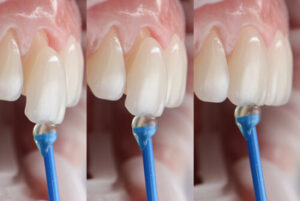Dental veneers, a cornerstone of cosmetic dentistry, have revolutionised how we enhance our teeth’ appearance. But how do veneers work? In essence, they are thin, tooth-coloured shells, typically made from porcelain or composite resin, designed to cover the front surface of teeth, offering a natural and improved look.
Porcelain veneers, known for their durability and natural appearance, are commonly applied to rectify cosmetic concerns such as chipped or broken teeth and severe discolouration and even to bridge gaps or align crooked teeth. These traditional porcelain veneers typically require enamel removal, which may involve a local anaesthetic. On the other hand, composite veneers, made from composite resin materials, offer a quicker, often reversible alternative, although they might need to match the longevity of their porcelain counterparts.
The veneer procedure starts with a dentist evaluating the natural teeth, followed by a tooth preparation process, which differs based on whether you choose traditional porcelain veneers, no prep veneers, or composite resin veneers. For porcelain veneers, the dentist trims the tooth surface, takes an impression, and sends it to a dental laboratory where each is custom-made. Composite veneers, however, can be sculpted directly onto the teeth.
This article aims to demystify the veneer procedure, from understanding the difference between porcelain and composite resin veneers to how they compare to other dental procedures like teeth whitening or dental crowns. Understanding how these solutions work is crucial in deciding whether you’re considering porcelain or composite resin veneers for cosmetic enhancement. We’ll delve into what makes veneers a popular choice for those seeking to improve the appearance of their teeth, how long veneers last, and the various types available, including traditional, prep, and no prep veneers.
What Are Dental Veneers?
Dental veneers are a prominent feature in cosmetic dentistry, offering a solution to enhance the appearance of your teeth. Essentially, they are custom-made, thin, tooth-coloured shells designed to cover the front surface of teeth, improving aesthetics and masking dental imperfections. Veneers can address various cosmetic concerns, such as chipped or broken teeth, severe discolouration, misshapen teeth, or even gaps between teeth.
The history of veneers dates back to the early 20th century. Originally, temporary dental veneers were developed for actors to change their teeth’ appearance temporarily. Over time, advancements in dental procedures and materials have led to the development of more durable and natural-looking solutions, like the porcelain veneers we see today.
Understanding how veneers work involves recognising their role in improving teeth’ colour, shape, and alignment. Whether opting for porcelain or composite resin veneers, they are bonded to the natural tooth using dental cement. This process is typically irreversible, making veneers a permanent commitment to enhancing the cosmetic appearance of your teeth. Veneers can be applied to front teeth, back teeth, or all teeth, depending on the individual’s needs and the dentist’s recommendation.
In summary, dental veneers offer an effective way to improve the appearance of your teeth, whether you’re dealing with discolouration, chipped teeth, or other cosmetic concerns. With proper care, veneers can significantly enhance your smile, boosting aesthetics and confidence.
The Process of Getting Veneers
Initial Consultation and Examination
Getting dental veneers begins with a cosmetic dentist’s initial consultation and examination. During this appointment, your dentist evaluates your teeth to determine if veneers suit you. This evaluation focuses on understanding your cosmetic concerns, such as chipped teeth, severe discolouration, crooked teeth, or other dental issues. The dentist also assesses the overall health of your existing teeth and gums to ensure that veneers are a viable solution.
Tooth Preparation
Preparation for traditional porcelain veneers typically involves the dentist trimming a small amount of enamel from the front surface of each tooth to make room for the veneer. This process ensures that the veneers fit comfortably and look natural. Enamel removal might be significantly less or non-existent for composite resin veneers or no prep veneers. Local anaesthetics may be used to ensure comfort during this stage.
Veneer Fabrication
Once your teeth are prepared, the dentist takes an impression of your teeth, which is sent to a dental laboratory. Here, skilled technicians craft your custom porcelain veneers, which may take several weeks. In the meantime, temporary veneers may be placed to protect your prepared teeth. Composite resin veneers can often be crafted directly on the teeth in a single visit, eliminating the need for a dental laboratory.
Applying the Veneers
In summary, getting veneers involves several key steps: consultation, tooth preparation, veneer fabrication, and application. Whether you choose porcelain or composite resin veneers, the process is meticulous, aiming to improve your teeth’ aesthetic and functional aspects. Dental veneers offer a transformative cosmetic dentistry option, providing a long-lasting solution to dental imperfections.
Benefits of Veneers
Cosmetic Enhancement
Veneers, thin tooth-coloured shells typically made from porcelain or composite resin, offer a transformative solution for enhancing the appearance of your teeth. They effectively address cosmetic concerns such as chipped or broken teeth, severe discolouration, and crooked teeth. Whether it’s porcelain veneers or composite veneers, they can be tailored to match the natural tooth structure, ensuring an improvement in the overall appearance of your teeth.
Durability and Longevity
One of the significant advantages of dental veneers, particularly traditional porcelain veneers, is their durability. As a robust material, porcelain veneers can withstand wear and tear, making them a long-lasting solution. Veneers last for many years with proper care, such as regular teeth brushing and avoiding habits like using your teeth as fingernails. They are more durable compared to other cosmetic dentistry options like teeth whitening.
Improvement in Oral Health
While veneers are primarily cosmetic, they also contribute to oral health. Covering the front surface of teeth protects against further damage and can aid in managing issues like tooth decay. The process involves minimal enamel removal, preserving most of the natural tooth. Veneers can improve bite and chewing efficiency in cases of unusually shaped teeth or smaller than average teeth.
Integration with Other Dental Procedures
Veneers can be combined with other dental procedures for comprehensive dental care. They work well with dental crowns, especially for back teeth. For those who cannot undergo extensive dental procedures, options like no prep veneers or snap-on veneers offer a less invasive solution.
In summary, porcelain or composite resin veneers effectively enhance cosmetic appearance, provide durability, and contribute to oral health. They have become popular in cosmetic dentistry and suit various dental issues.
Potential Drawbacks and Considerations
While dental veneers offer a transformative solution for various cosmetic concerns, it’s important to understand their potential drawbacks and considerations.
Sensitivity and Discomfort
One of the immediate concerns following the veneer procedure, especially with traditional porcelain veneers, is sensitivity. This occurs because a portion of the natural tooth enamel is removed during tooth preparation, potentially leading to sensitivity to hot and cold foods and beverages. Some individuals may experience temporary discomfort following the procedure, although this typically subsides. Composite veneers generally involve less enamel removal, potentially reducing sensitivity issues.
Cost and Insurance Considerations
The cost of veneers, particularly porcelain veneers, can be a significant consideration for many. Porcelain veneers are often more expensive than composite resin veneers due to the materials used and the process involved, including the work of a dental laboratory. Moreover, since veneers are typically considered a cosmetic procedure, they are often not covered by dental insurance. It’s important to consult with your dentist and insurance provider to understand the full scope of the costs involved and what, if any, portion may be covered.
Maintenance Requirements
Maintaining veneers is crucial for their longevity. Although dental veneers, especially porcelain veneers, are durable, they are not indestructible. Careful teeth brushing, avoiding habits like using your teeth as tools (for example, to open packages or bite fingernails), and refraining from biting into hard foods can extend the lifespan of your veneers. Furthermore, while veneers resist staining, good oral hygiene practices are essential to maintain their appearance and the health of the surrounding natural teeth and gums.
In summary, while dental veneers, be they traditional porcelain veneers or composite resin veneers, offer a viable solution for enhancing the appearance of your teeth, it’s important to consider the potential sensitivity, costs, and maintenance requirements. Understanding these factors will help ensure you are fully informed and prepared for this cosmetic dentistry procedure.
Comparing Veneers with Other Dental Procedures
Veneers vs. Braces
Dental veneers and braces serve different purposes in cosmetic dentistry. Veneers, thin porcelain or composite resin shells, are used for cosmetic enhancement. They address chipped teeth, severe discolouration, and minor misalignments. Conversely, braces are orthodontic devices that correct more significant alignment and bite issues. While veneers provide a quicker cosmetic fix, braces offer a long-term solution for structural dental problems.
Veneers vs. Crowns
Both dental veneers and crowns improve the appearance of teeth, but they differ in application and coverage. Veneers are thin layers that cover only the tooth’s front surface, making them suitable for cosmetic improvements. Crowns, however, cover the entire tooth and are used when there is significant damage or decay. They provide more structural support than veneers but require extensive tooth preparation, including enamel removal.
Veneers vs. Teeth Whitening
Teeth whitening and veneers are both popular for enhancing the appearance of your teeth. Teeth whitening is a less invasive procedure designed to remove stains and lighten the colour of natural teeth. It’s a suitable option for those whose primary concern is discolouration. While addressing discolouration, veneers cover other cosmetic concerns like chipped or broken teeth and gaps. They offer a more comprehensive solution for cosmetic enhancement compared to teeth whitening.
In conclusion, choosing between veneers, braces, crowns, and teeth whitening depends on the specific dental needs and cosmetic goals. While veneers offer a versatile and less invasive option for cosmetic enhancement, braces and crowns address more significant dental issues. Teeth whitening, while effective for discolouration, doesn’t provide the structural, cosmetic benefits of veneers. Consulting with a cosmetic dentist is essential to determine the most appropriate treatment for dental concerns.
Care and Maintenance of Veneers
Proper care and maintenance are crucial for ensuring the longevity and appearance of dental veneers. Whether you have porcelain or composite resin veneers, a consistent oral hygiene routine and awareness of certain habits can help maintain their quality.
Daily Care Tips
Good oral hygiene is key to caring for your veneers. This includes brushing and flossing to prevent tooth decay and gum disease. Use a non-abrasive toothpaste and a soft-bristled toothbrush to avoid damaging the surface of the veneers. Although veneers are stain-resistant, especially porcelain veneers, maintaining a routine of brushing and flossing will help preserve their appearance and the health of your natural teeth.
Regular Dental Check-Ups
Regular visits to your dentist are essential for maintaining veneers. During these check-ups, your dentist evaluates the condition of your veneers, the health of your natural teeth, and the overall health of your mouth. These appointments are an opportunity to address any issues early and to get professional cleanings, which help maintain the veneers and natural tooth structure.
What to Avoid
In summary, caring for your dental veneers involves diligent oral hygiene, regular dental visits, and being mindful of habits that could damage them. Whether you have traditional porcelain veneers or composite resin veneers, these steps are essential to ensure that your investment in your smile lasts as long as possible.
Conclusion
In summary, dental veneers present a transformative option for those looking to enhance the aesthetic appeal of their teeth. Whether addressing issues like chipped or broken teeth, severe discolouration, or misaligned teeth, veneers offer a custom solution tailored to individual needs. Porcelain veneers and composite resin veneers have unique advantages, with porcelain offering unparalleled durability and a natural appearance. In contrast, composite resin provides a less invasive and often more cost-effective alternative.
Obtaining veneers involves several key steps: an initial consultation, tooth preparation, veneer fabrication, and application. This journey, while intricate, leads to a significant improvement in the appearance of your teeth, contributing to greater confidence and a brighter smile.
However, considering potential drawbacks, such as sensitivity, cost, and maintenance requirements, is essential. Understanding these factors will help in making an informed decision. Once veneers are in place, their care and maintenance are paramount to ensure longevity and sustained appearance. Regular oral hygiene, avoiding certain habits, and consistent dental check-ups are crucial.
If you’re considering veneers, it’s vital to consult with a dental professional who can provide personalised advice and guidance based on your specific dental needs. For those in Sydney seeking expert advice and high-quality dental veneer services, MyHM Dentist stands ready to assist. Their team of experienced cosmetic dentists can help you understand how veneers work, what you can expect from the procedure, and how it can transform your smile.
We encourage you to take the first step towards a more confident and radiant smile by contacting MyHM Dentist in Kellyville NSW at (02) 9158 6379. Our team will happily schedule a consultation and help you explore the possibilities that veneers can offer. Remember, a beautiful smile is not just about aesthetics; it’s about expressing your confidence and personality. Let MyHM Dentist be your partner in achieving your desired smile.
References:
https://www.ncbi.nlm.nih.gov/pmc/articles/PMC6076883/
www.dentalnews.com/2023/07/14/understanding-porcelain-veneers-a-comprehensive-guide.
https://www.healthline.com/health/dental-veneers
https://www.webmd.com/oral-health/veneers








